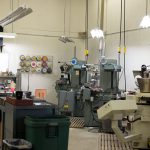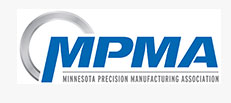 The progressive die stamping process is used for converting a flat strip of metal into useful parts as per the print specifications. As the name suggests, a progressive stamping die is used in this process. It is a metalworking device. Essentially, progressive die stamping may be defined as a cutting and forming process wherein sheet metal supplied on a coiled strip goes through a series of simultaneous operations on various stamping stations. As the sheet metal keeps passing through the stamping die, the final metal work-piece keeps getting developed progressively or incrementally and this is why it is known as the progressive stamping die process.
The progressive die stamping process is used for converting a flat strip of metal into useful parts as per the print specifications. As the name suggests, a progressive stamping die is used in this process. It is a metalworking device. Essentially, progressive die stamping may be defined as a cutting and forming process wherein sheet metal supplied on a coiled strip goes through a series of simultaneous operations on various stamping stations. As the sheet metal keeps passing through the stamping die, the final metal work-piece keeps getting developed progressively or incrementally and this is why it is known as the progressive stamping die process.
In this process, it die is first placed in the right position in the stamping press. The metal die opens up when the stamping press moves up and it closes when the press moves down. The metal keeps moving through the die when it’s open. A pre-set length of the metal strip is fed into the stamping die with each press stroke. The stamping die can be used for modifying raw sheet metal in a variety of ways including embossing, drawing, lancing, extruding, burnishing, shaving, coining, bending and cutting.
The stamping job is completed when the die closes and the finished part gets ejected from the die. The finished parts can be connected to a carrier strip or be completely separate and these are supplied on a returnable or disposable reel.
Each press stroke involves movement of the strip metal a certain distance and it is known as the pitch or feed progression. The pitch refers to the distance between different stations.
The metal strip also has some unwanted parts and these are cut out as the metal keeps advancing through the stamping die. One or more tabs or ribbons are left aside to the partially completed part to allow it to go through the remaining stamping stations.
In a progressive die, the metal strip is fed through the stamping die and the parts remain connected to this strip. The stock metal strip is pushed forward with the help of automatic feeds and pilots are used to position it accurately at high speeds. In a progressive die, each station has to do some additional work on the metal piece being worked on which means the strip needs to be moved precisely in order to align it right within thousandths of an inch every single time it moves. To move and position it accurately, conical or bullet shaped pilots are used. These pilots enter previously pierced holes in the metal strip to keep the sheet metal aligned as it cannot be done with the help of feeding mechanism.
A progressive die has various components and each of these components perform different operations on the sheet metal. These components of the die are located in plates wherein they are guided in precision cut openings at each press stroke. These plates are located on the pins that guide these plates. A mechanical press actuates the entire stamping die as it keeps moving the die up and down. To move the sheet metal strip through the die, a press feeding mechanism is used that moves the material from one station to another after each press stroke.
Benefits of Progressive Die Stamping Process:
Simultaneous operations that utilize cutting and/or forming
Ability to produce various components at a quick pace
Ability to produce multiple parts with each press stroke
Fast setup
Part location is well controlled throughout the stamping process
Precision with close tolerances
High press tonnage





